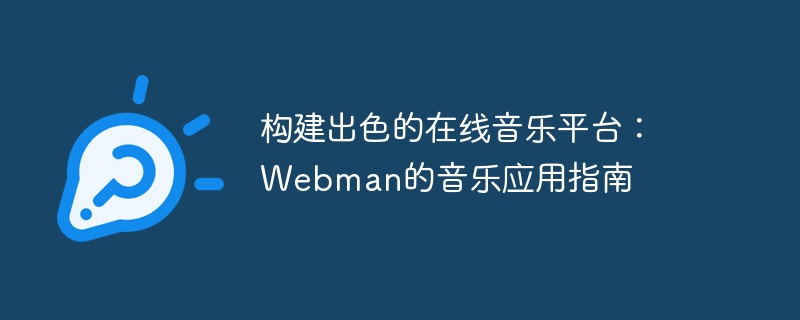构建出色的在线音乐平台:Webman的音乐应用指南
- PHPz原创
- 2023-08-13 13:52:461467浏览

构建出色的在线音乐平台:Webman的音乐应用指南
导言
在数字化时代,音乐已经成为人们生活中不可或缺的一部分。作为开发者,我们可以通过构建一个功能强大、用户友好的在线音乐平台,为用户提供丰富多样的音乐体验。本文将介绍如何使用Web技术构建一个出色的在线音乐应用,引导开发者一步步实现这一目标。
- 架构设计
在构建Web应用之前,我们需要对架构进行设计。常见的音乐平台架构通常由客户端、服务器端和后端三个主要组件组成。
客户端:负责用户界面的展示和交互。我们可以使用HTML、CSS和JavaScript构建跨平台的响应式界面。以下是一个简单的示例:
<!DOCTYPE html>
<html lang="en">
<head>
<meta charset="UTF-8">
<meta name="viewport" content="width=device-width, initial-scale=1.0">
<title>Webman Music Player</title>
<link rel="stylesheet" href="styles.css">
</head>
<body>
<header>
<h1>Webman Music Player</h1>
</header>
<main>
<!-- 歌曲列表 -->
<ul id="song-list">
</ul>
<!-- 播放控制器 -->
<div id="player-controls">
<button id="play-button">播放</button>
<button id="pause-button">暂停</button>
<button id="next-button">下一首</button>
</div>
</main>
<script src="main.js"></script>
</body>
</html>服务器端:负责与客户端进行通信和数据交换。我们可以使用Node.js构建一个轻量级服务器,处理来自客户端的请求和提供音乐数据的接口。以下是一个简单的示例:
const http = require('http');
const server = http.createServer((req, res) => {
if (req.url === '/api/songs') {
const songs = [
{ title: 'Song 1', artist: 'Artist 1' },
{ title: 'Song 2', artist: 'Artist 2' },
// ...
];
res.writeHead(200, { 'Content-Type': 'application/json' });
res.end(JSON.stringify(songs));
}
});
const port = 3000;
server.listen(port, () => {
console.log(`Server running on port ${port}`);
});后端:负责音乐数据的存储和管理。我们可以使用数据库来存储歌曲信息、用户信息和播放记录等。例如,我们可以使用MongoDB存储歌曲信息,以下是一个简单的示例:
const mongoose = require('mongoose');
mongoose.connect('mongodb://localhost/music-app', { useNewUrlParser: true, useUnifiedTopology: true })
.then(() => console.log('Connected to database'))
.catch(error => console.log(`Database connection error: ${error}`));
const songSchema = new mongoose.Schema({
title: String,
artist: String,
});
const Song = mongoose.model('Song', songSchema);
// 创建一首新歌曲
const newSong = new Song({ title: 'Song 1', artist: 'Artist 1' });
newSong.save()
.then(() => console.log('Saved new song'))
.catch(error => console.log(`Error saving song: ${error}`));- 功能开发
在构建音乐平台时,我们可以根据需求开发以下功能:
- 歌曲播放和暂停功能:通过JavaScript控制音频元素的播放和暂停,例如:
const audio = new Audio();
const playButton = document.getElementById('play-button');
const pauseButton = document.getElementById('pause-button');
playButton.addEventListener('click', () => {
audio.play();
});
pauseButton.addEventListener('click', () => {
audio.pause();
});- 歌曲列表显示功能:通过JavaScript从服务器获取歌曲数据,并动态生成HTML元素展示给用户,例如:
const songList = document.getElementById('song-list');
fetch('/api/songs')
.then(response => response.json())
.then(songs => {
songs.forEach(song => {
const listItem = document.createElement('li');
listItem.textContent = `${song.title} - ${song.artist}`;
songList.appendChild(listItem);
});
});- 用户注册和登录功能:可以使用表单和服务器端验证实现用户注册和登录功能,并在后端存储用户信息。
- 搜索歌曲功能:通过输入关键字搜索歌曲,并展示匹配的歌曲列表给用户。
- 部署和测试
在功能开发完成后,我们需要将应用部署到服务器上,并进行测试以确保其正常运行。
可选择使用云服务提供商,如AWS、Azure或Google Cloud进行部署,或者使用传统的虚拟主机服务。对于服务器端,你可以使用Nginx或Apache服务器作为Web服务器,并确保与客户端的通信正确。
测试时,可以使用不同的设备和浏览器,在各种网络环境下测试应用的稳定性和响应速度。同时,对于用户界面和交互进行全面的测试,确保功能完整、易用性。
结语
通过构建一个出色的在线音乐平台,我们可以为用户带来极大的便利和乐趣。本文介绍了音乐应用的架构设计、功能开发和部署测试等方面的内容,希望能够帮助开发者构建一个高质量的音乐应用。祝愿你的Webman音乐应用能够吸引众多用户,成为音乐爱好者的首选平台!
以上是构建出色的在线音乐平台:Webman的音乐应用指南的详细内容。更多信息请关注PHP中文网其他相关文章!

